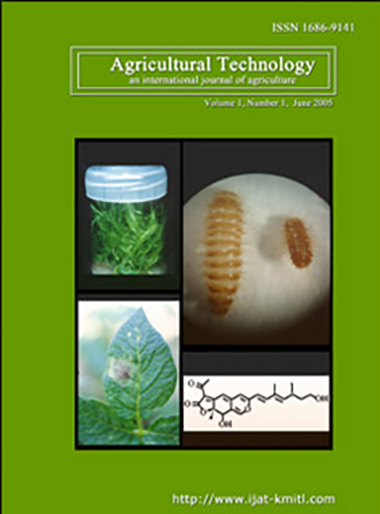Identification of fungal phyto-pathogens by Fourier-transform infrared (FTIR) microscopy
Main Article Content
Abstract
Fungi are considered as serious pathogens to many plants and can cause a severe economic
damage. Early detection and identification of these pathogens is very important and might be
critical for their control. The available methods for identification of fungi are time consuming
and not always very specific. Fourier-transform infrared (FTIR) microscopy is proved to be a
reliable and sensitive method for detection of molecular changes in cells. In the present study
we used FTIR microscopy as a sensitive and effective assay for the detection and
discrimination between different genera of fungi. Our results showed significant spectral
differences between the various examined fungal genera.
Article Details

This work is licensed under a Creative Commons Attribution-NonCommercial-NoDerivatives 4.0 International License.
References
Brandenburg, K. and Seydel, U. (2002). Vibrational spectroscopy of carbohydrates and glykoconjugates. Handbook of Vibrational Spectroscopy. John Wiley & Sons, Chichester: UK: 3481-3507.
Diem, M., Boydstom-White, S. and Chiriboga, L. (1999). Infrared spectroscopy of cells and tissues: shining light onto a novel subject. Applied Spectroscopy 53: 148-161.
Dukor, R.K. (2002). Vibrational spectroscopy in the detection of cancer. Handbook of Vibrational Spectroscopy, John Wiley & Sons, Chichester: UK: 3335-3360.
Gordon, S.H., Jones, R.W., McClelland, J.F., Wicklow, D.T. and Greene, R.V. (1999). Transient onfrared spectroscopy for detection of toxigenic fungi in corn: potential for on-line evaluation. Journal of Agriculture Food Chemistry 47: 5267-5272.
Huleihel, M., Erukhimovitch, V., Talyshinsky, M. and Karpasas, M. (2002). Spectroscopic characterzition of normal primary and malignant cells transformed by retroviruses. Applied Spectroscopy 56: 640-645.
Maquelin, K., Choo-Smith, L.P., Kirschner, C., Ngo-Thi, N.A., Naumann, D. and Puppels, G.J. (2002). Vibrational spectroscopic studies of microorganisms. Handbook of Vibrational Spectroscopy. John Wiley & Sons, Chichester: UK: 3308-3334.
Maquelin, K., Kirschner, C., Choo-Smith, L.P., Ngo-Thi, N.A., Vreewijk, V., Stammler, M., Endtz, H.P., Bruining, H.A., Naumann, D. and Puppels, G.J. (2003). Prospective study of the performance of vibrational spectroscopies for rapid identification of bacterial and fungal pathogens recovered from blood cultures. Journal of Clinical Microbiology 41: 324-329.
Mariey, L., Signolle, J.P., Amiel, C. and Travert, J. (2001). Discrimination, classification, identification of microorganisms using FTIR spectroscopy and chemometrics Vibrational Spectroscopy 26: 151-159.
Rigas, B., LaGuardia, K., Qiao, L., Bhandare, P.S., Caputo, T. and Cohenford, M.A. (2000). Infrared spectroscopic study of cervical smears in patients with HIV: implications for cervical carcinogenesis. Journal of Laboratory and Clinical Medicine 35: 26-31.
Salman, A., Erukhimovitch, V., Talyshinsky, M., Huleihil, M. and Huleihel, M. (2002). FTIR- spectroscopic method for detection of cells infected with herpes viruses. Biopolymers 67: 406-412. 151
Wong, P., Goldstein, S., Grekin, R., Godwin, A., Pivik, C. and Riga, B. (1993). Distinct infrared spectroscopic patteren of human basal cell carcinoma of the skin. Cancer Research 53: 762-765.
Yang, D., Castro, D., EI-Sayed, I., EI-Sayed, M., Saxon, R. and Nancy, Y. (1995). A Fouriertransform infrared spectroscopic comparison of cultured human fibroblast and fibrosarcoma cells. SPIE 2389: 543-550.


